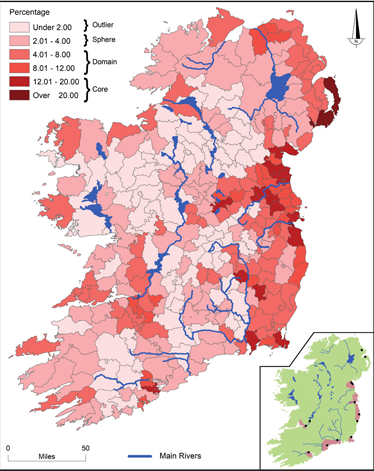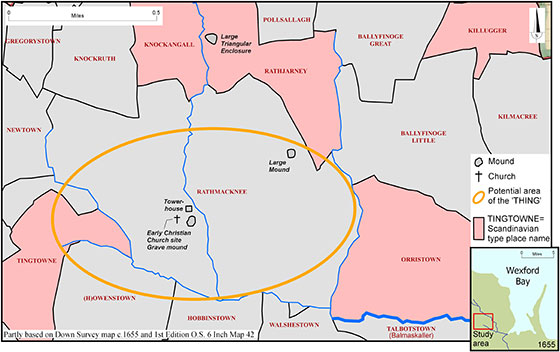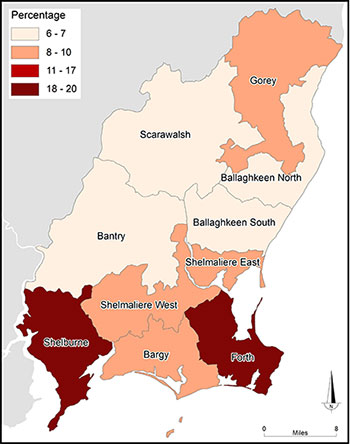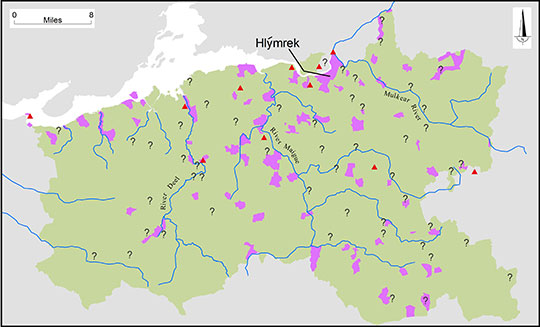The Scandinavian impact—a geographical evaluation
Published in Features, Issue 2 (March/April 2020), Volume 28Place-name evidence suggests that Scandinavian rural settlement in Ireland was more extensive than is currently assumed.
By William J. Smyth
The Vikings were outstanding geographers. Their sea empire(s) stretched down the great rivers of continental Russia to reach Byzantium, while extending westwards to colonise Iceland, Greenland and even the edges of North America. To these Vikings, Wexford, Limerick and, indeed, all of Ireland constituted a single coastland. The thesis being explored here is that—operating over a massive time-span and involving much intermixing of populations, material cultures and language—the cumulative Viking (c. 800–c. 950/980), Hiberno-Scandinavian (c. 980–1170) and Scandinavian-Irish (post-1200) impact on Ireland was culturally deeper and geographically more extensive than much of the literature suggests. Such an interpretation has been occluded by powerful orthodoxies. While Scandinavian settlement elsewhere was seen as predominantly rural, since the mid-nineteenth century Ireland’s colonial experience has been seen as largely exceptional and essentially urban. A second assumption has been that, apart from a scattering of obvious English-language place-names, all Irish place-names are still in the Irish language or are Anglicised versions of such Irish-language names.
Orthodoxies challenged
John Bradley (1988) challenged these orthodoxies when he documented the extent of rural Scandinavian settlement (inset, Fig. 1). In turn, I have been exploring what a geographical approach to Irish place-name evidence has to offer the following research question: is it possible that Ireland was not that different from other northern European colonies of the Norse and Danish and that, apart from the influential towns, rural settlement was more widespread than is allowed for in the existing literature?
The study of place-names is always a contested field and in Ireland it remains a treacherous terrain. Apart from Latin and Medieval French impulses, there have been, for over a millennium, oscillating encounters between Celtic and Germanic languages (including Old Norse [ON]) in Ireland. Place-names in Ireland therefore constitute a complex and unstable terrain characterised by phonetic transformations, (mis)interpretations, Anglicisation and re-Gaelicisation. To paraphrase John Montague’s The rough field (1972), one plunges with seven-league boots into this place-name world and ends up in a bogland of uncertainties.
Only about 40% of Irish townland names known today were documented before the 1660s. A first step in this geographic analysis is to compare the townland forms found in the ‘1659 Census’ (c. 19,000 names) and Goblet’s topographical index of place-names recorded on all of Petty’s mid-seventeenth-century maps (c. 25,000) with their equivalents throughout the Scandinavian colonial world. Essential to such a project are both detailed documentary work and exploratory fieldwork across this extensive Atlantic world. Early path-finding studies of Scandinavian influences on Gaelic Scotland demonstrated that massive Gaelicisation of Norse names made it difficult for Scottish scholars to decipher their deeper Scandinavian roots. In both the Hebridean islands of Lewis and Islay, about 250 Old Norse loan-words—involving personal, topographic and habitative names—were found embedded in the local place-names. How many of these name forms might also exist in Ireland?
Place-names with Scandinavian affiliations

Above: Fig. 1—Distribution of place-names with assumed Scandinavian-type place names as a percentage of the total number of mid-nineteenth-century townlands in each respective barony. These geographic patterns are indicative rather than conclusive. More detailed research is necessary to verify or modify the distributions. This map uses the concepts developed by geographer Donald Meinig (1965) to describe the dynamic structure of cultural regions. Inset: John Bradley’s 1988 map of Hiberno Scandinavian settlement. (Mike Murphy)
Migrating out of Ireland around 900 to Cumbria, Lancashire and north Yorkshire, Scandinavian settlers had spent long enough in Ireland (and the Hebrides) to use Scandinavian words in a Celtic rather than a Germanic formation (generic preceding specific, as in Kirkbride vis-à-vis Bridekirk); they brought new personal names and adopted Gaelic place-name generics like Ergh/Argh and Kró (indicative of a rural background) and embedded these in the northern English topography. Such fossilised names might provide further clues to Norse-Irish naming strategies in east-coast Ireland. Or were these names obscured later by Anglo-Norman impositions? The Isle of Man, long under the commercial and cultural influence of Scandinavian Dublin, saw Scandinavian terms for ‘farm’, whether staðir or by(r), transformed into the Manx balla in the eleventh- and twelfth-century Gaelic revival. Did ‘Bally’ come to play a similar role in Ireland? Hugh Marwick’s Orkney farm-names (1952) is a revelation. The exact same place-name form ‘Howth’ (ON hofði, head-shaped hillock) is found in both countries. At least 30 place-name particulars are shared between Ireland and the Orkneys. Importantly, in the Orkneys staðir is regularly returned as ‘ston’, much less often as ‘sta’ and ‘stay’. It therefore need not be assumed that ‘ston’/‘ton’/‘town’ endings in Ireland are always necessarily post-Norman. These Scandinavian colonial worlds provide a variety of mirror-images through which to explore the sixteenth- and seventeenth-century Irish evidence and so help to generate a provisional barony map of place-names with assumed Scandinavian affiliations (Fig. 1).
A fundamental law of place-name studies is to identify the earliest documented forms of a name to interpret its original meaning. The Irish Placenames Commission (IPC) volumes for counties Wexford (WX) and Limerick (LK) provide such documentary evidence and linguistic interpretations. Verification of the evidence can then be undertaken using geographical principles and approaches. Geographers are specialists in the understanding of places. One can ‘walk’ across the townlands of these counties via the illuminating OS half-inch maps, and more especially their first-edition six-inch maps. The six-inch map allows for the exploration of ancient burial places, monuments, church dedications and minor place-names which may be of older vintage and provide clues to place-name origins. Then comes the actual fieldwork—one leaves the car, following up key questions, searching out problematic sites and seeking to understand the Scandinavian settlers’ locational preferences.
Rathmacknee locality
South of the town of Wexford (Waesfjord/Ueigs-fjörðr, ‘mud flats bay’) in Forth barony, the locality around Rathmacknee (Ráth Mhac nAodha) provides interesting insights. The three key townlands here are Rathjarney, Rathmacknee and Ting. Rathjarney—with its strong ‘j’ sound—presents difficulties as an Irish-language word. The Norse byname Jarn-kné (‘Iron Knee’), however, translated by the Irish as Glún-iarann, is well known in the ninth- and tenth-century annals. Rathmacknee remembers the ancient capital of the Fothairt kingdom, likely taken over by a Viking leader (perhaps Jarn-kné) and his followers in the 880s. The Irish annals record Viking activity in the Wexford region at this time.
Ting—Tingtowne in 1655—has long been recognised as the ON form Þing, the arena where the élite and the community met for political and judicial decision-making. The IPC Wexford volume argues that the derivation of Ting (‘if an Irish word’) is from the Irish toinn, meaning ‘bog, swamp’. The authors describe this derivation as straightforward and find no historic or linguistic reference to the contrary. The geographic evidence, however, is to the contrary. The fieldwork evidence shows that the townland is not a bog or swamp but well-drained good land on a slope running down to the nearby stream. Here, I argue, we can identify a classic ‘thing assembly’ landscape, characteristic both of the Scandinavian homelands and of the Scandinavian colonial world. All such assembly landscapes included (1) good communication routes and access (by sea and land, as at Rathmacknee); (2) an association with an administrative district (here at the old core of the Fothairt kingdom); (3) a landscape where the function of a platform for law-speakers and others is fulfilled by the þingbrekka, the ‘thing-slope’ (as in the townland of Ting); and (4) an area proximate to ancestral burial grounds and prehistoric sites (the Rathmacknee mounds and a ploughed-out barrow to the south-east). Features associated with a fully-fledged Scandinavian community with its own rituals and customs are found here (Fig. 2).

Above: Fig. 2—The Rathmacknee locality c. 1655. In the medieval era, tidal streams from Wexford Bay gushed into this locality, creating a veritable waterway in the heart of Forth barony. (Mike Murphy)
Forth barony

Above: Fig. 3—Distribution per barony in County Wexford of assumed Scandinavian-type place-names as a percentage of the total number of mid-nineteenth-century townlands in each respective barony. These distributions are indicative rather than conclusive. (Mike Murphy)
Forth barony (long known as the ‘cantred of the Ostmen’) has around 70 place-names with Scandinavian affiliations out of about 200 in the county as a whole. Therefore around a third of all the presumed ‘Scandinavian-type’ names are located here. The baronies of Bargy, Shelburne, Shelmalier and Ballaghkeen each contain c. 10% of Wexford’s total of such names, constituting a middle zone in terms of Viking/Scandinavian-Irish impact. More upland and inland, Bantry and Scarawalsh are somewhat marginal, each with c. 7% of the total. The initial surprise—but not when one takes into account the reach of Viking Arklow and Dublin—is the strength of Gorey barony to the north, with 25–30 such names and c. 12–13% of the total. A further analysis is to measure the assumed Viking/Scandinavian-type place-names as a percentage of the total number of townlands in each respective barony. Forth’s proportion drops to 18–20%, given its large number of townlands (411). Shelburne marks the greatest change, now also at c. 18% out of a total of 127 townlands. So the significance of this Waterford harbour/Bannow Bay-bounded barony now swims into view, reflecting the influence of the Vikings from the harbour—*Vedrafjord (‘[good] weather harbour’)—and the later Hiberno-Scandinavian town of Waterford (see Fig. 3).
Limerick
Moving from east-coast Wexford to a western world, the place-names identified for County Limerick indicate Scandinavian penetration along the Mulkear River, the Maigue and its many tributaries, the Deel valley and even some minor rivers (Fig. 4). It was not these well-watered rich limestone lands that proved an obstacle to the Vikings; it was the mosaic of major and minor kingdoms of Limerick’s deeply mythologised, Christianised and humanised world that offered resistance. Yet the Viking conquerors pushed the Deis Tuaiscirt well north of the Shannon into mid-Clare when establishing their kingdom around what was to become the Hiberno-Viking town of Hlýmrek (although the resurgent Dál Cais under Mathgamain and Brian Bóramha came back to wreak revenge in the latter half of the tenth century). The Vikings established good relations with the Uí Fhidgente kingdom in the mid-west and also apparently with the Eoganacht Áine to the east, opening a pathway to Cashel and beyond. The place-name evidence sometimes confirms where the Viking conquerors took over the dúns (fortresses), displacing the local lords. In other instances the juxtaposition of place-names indicates co-existence. The Limerick pattern strongly suggests control of the economy via all communication routes by the regional capital, Hlýmrek.

Above: Fig. 4—Distribution in County Limerick of assumed Scandinavian-type place-names. Question marks refer to the more doubtful/unclear categories in this distribution. Red triangles indicate Scandanavian hoards or other such finds. (Mike Murphy)
Carrying out the necessary detailed documentary and fieldwork research on townlands and civil parishes in other counties, scholars may confirm, modify or challenge the geographic patterns and interpretations presented here. The map of Ireland (Fig. 1) is based on a wide range of comparative geographic approaches. What it makes clear is that, outside the towns, Scandinavian settlement and influence were widespread. Current archaeological research is enlarging this perspective. It is clear—as illustrated for Scandinavian Scotland, northern England and elsewhere—that it is necessary to look again at the complexity of Ireland’s place-name heritage.
William J. Smyth is Emeritus Professor of Geography at University College Cork.
Read More:
Three times as many Norse place-names?
FURTHER READING
J. Bradley, ‘The interpretation of Scandinavian settlement in Ireland’, in J. Bradley (ed.), Settlement and society in medieval Ireland (Kilkenny, 1988), 49–78.
A. Sanmark, Viking law and order: places and rituals of assembly in the medieval north (Edinburgh, 2017).
J. Sheehan & D. Ó Corráin (eds), The Viking Age: Ireland and the West (Dublin, 2010).
W.J. Smyth, ‘The Scandinavians of Wexford: place-name analysis with particular reference to Forth barony’, Journal of the Wexford Historical Society 27 (2018–19), 39–78.
















